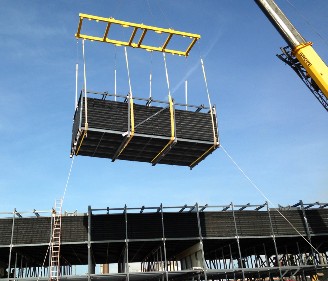制造业、化学加工和石油天然气精炼等重工业应用使用冷却塔和其他设备来冷却其运行中不可或缺的水。随着环境法规和严峻的市场条件对这些行业提出了更高的要求,改进的冷却技术正在涌现,以帮助应对挑战。

在石油和天然气行业,目前使用的许多冷却塔都是作为原始炼油厂建设的一部分而建造的,它们的使用寿命很快就要结束了。为了满足现代生产需求和行业要求,这些冷却塔必须升级或更换为更高效的产品,并且必须制定更好的长期维护计划。
冷却塔操作和类型
冷却塔是一种专用热交换器,通过使水与空气接触来降低水温。通过工业过程加热的水通过管道泵送到冷却塔。水通过喷嘴喷洒到称为填料的传热材料上,填料减缓了水流过冷却塔的速度,并尽可能多地暴露水面,以实现最大程度的空气与水接触。当水流过冷却塔时,它还会暴露在由电动机驱动的风扇抽过塔的空气中。
当水和空气相遇时,少量的水会蒸发,产生冷却作用。冷却后的水随后被泵送回工艺设备,在那里吸收热量。然后,它将被泵送回冷却塔再次冷却。
不同类型的冷却塔适合不同的工业冷却需求。现场安装塔 (FEP) 是在现场建造的,专为大热负荷而设计,并针对特定应用进行设计。
现场竖立塔 非常适合电力和重工业用途,并且经常用于炼油厂和化学加工厂。
工厂组装的塔 (FAP)在制造工厂以模块形式构建,然后以尽可能少的部件运送到加工厂进行最终组装。工厂组装的塔有多种冷却容量和箱体尺寸,包括标准化的机械和结构部件。
对于炼油厂和化学加工厂来说,开路湿式冷却塔(与管壳式或板框式热交换器相结合)是一种经济的散热方法。这些塔的设计符合湿球温度,可以将水冷却到比其他一些技术更低的温度。但是,炼油厂和加工厂也采用其他方法来实现冷却。
风冷热交换器
蒸发式冷却塔(如上文所述)使用传热填料来有效分配热工艺水并增加其表面积以实现更高效的冷却。但缺点是许多填料类型需要相对干净的水才能有效运行。含有颗粒和碎屑的低质量水会堵塞填料并降低性能。
对于水资源稀缺、无法获得或价格昂贵的情况,空气冷却式热交换器是一种替代冷却技术。空气冷却式热交换器专为处理石油和天然气及化学工艺中常见的高热负荷而设计,无需频繁维护,并且不会蒸发水进行冷却。
空气冷却式热交换器仅使用气流来冷却管道中的碳氢化合物产品和其他流体。来自工厂的热工艺流体流过翅片管,而冷却空气则流过翅片管。空气冷却式热交换器非常适合高温碳氢化合物应用。这些热交换器被石油和天然气行业采用,因为不需要水或水化学维护,并且它们不会产生蒸发塔的蒸汽羽流。但是,由于它们是为干球温度设计的,因此它们无法将水或工艺流体冷却到像湿式冷却塔那样低的温度。
其他专用热交换器如蒸发式冷凝器和闭路流体冷却器也用于冷却整个化工厂的工艺和流体。
石油和天然气面临的挑战
在石油和天然气精炼厂中,工业设备通常用流动的水包裹或包裹,以冷却流体和吸收工艺热量。这种设备会产生很大的热负荷,如果处理不当,可能会扰乱运行。冷却塔用于冷却这种工艺用水以供再利用。冷却塔必须能够处理热负荷以及任何行业特有的问题。工艺过程中的泄漏会导致碳氢化合物污染冷却水,反之亦然。通常使用质量较差的非饮用水来冷却工厂工艺。满足限制碳氢化合物、用水量和漂移率的环境法规对工厂操作员来说是一个挑战。新的行业法规通常要求冷却塔将漂移率降低到循环水流量的 0.0005%,而老式蒸发式冷却塔很难实现这一点。许多当前使用的冷却塔都没有能力满足这些要求。
几十年前,现场安装的冷却塔通常使用木质结构构件。这些冷却塔的使用寿命即将结束,经常出现机械故障,需要进行计划外维护,从而干扰生产并影响设施生产力。塔内的传热填料也会随着时间的推移而退化,被脏冷却水中的废物堵塞,并因碎屑的重量而破裂。
行业中很大一部分企业需要新冷却塔和更好的长期维护计划。“许多现有的冷却塔要么已经老化,要么缺乏适当的维护,”Christian Power Equipment Inc. 总裁 Alan Christian 说道,该公司专门生产电力、工艺和污染控制设备。“这非常重要,我称之为 [行业中的] 趋势。”
更换旧塔
更换老化的木制冷却塔是一项艰巨的任务。由于它们是生产过程中不可或缺的一部分,因此必须在短时间内完成维护、维修和更换。有些更换工作一次只更换一个冷却单元,这样工厂就可以继续运行——这种做法被称为在线施工。通常需要租用临时冷却设备。
为了应对更换物流方面的挑战和高成本,冷却塔制造商提供现场安装和工厂组装两种塔。炼油厂和化工厂可以使用模块化现场安装塔或针对项目和场地的预组装成套塔来更换老旧、老化的塔。
“许多炼油厂建于 1950 年至 1970 年之间,当时最初的塔楼已经建成。他们在 [塔楼] 周围建造了炼油厂,”Hastik-Baymont Inc. 的销售工程师 Pam McLaughlin 说道,该公司专门为石油和天然气及加工行业提供工程设备解决方案。“大多数地方,除非是新建的基层炼油厂,否则没有大量的停放区域来对已经竖立起来的盆地进行塔楼维修或更换。可用空间并不多。”
现场安装解决方案: 为了克服这些限制,一些制造商已将逆流、现场安装塔的生产和现场组装流程模块化。与传统的塔式建筑方法相比,模块化冷却塔通常安装速度更快,需要的场地面积更少,同时提供相同的能力来应对大量热负荷。模块化组件可以“及时”运送到施工现场,从而减少施工时间和人力需求。组装过程安全,统一的工厂组装模块可确保产品质量始终如一。
工厂组装塔注意事项: 工厂组装的冷却塔是石油和天然气应用的可行替代方案。它们提供快速交付和安装以及更大的场地布置灵活性。它们还可以缩短停机时间和生产时间损失。如果进行扩展,可以添加额外的单元以提供更多的冷却能力。专为工艺应用设计的工厂组装冷却塔有逆流或横流设计,包括重型、耐腐蚀的结构部件和机械传动系统,具有可靠性和长使用寿命。
总之,由于环境和市场需求给石油和天然气炼油厂和化学加工厂带来压力,他们必须采取措施确保其设施和设备现代化和高效。必须用新技术取代老化的冷却系统,采用耐用的材料和部件制造,由信誉良好的制造商提供支持,并由知识渊博的工程师和服务技术人员提供支持。冷却系统还必须成为全面监测和维护计划的一部分,以延长设备的盈利使用寿命,并在危机发生前提醒工厂注意潜在问题。

